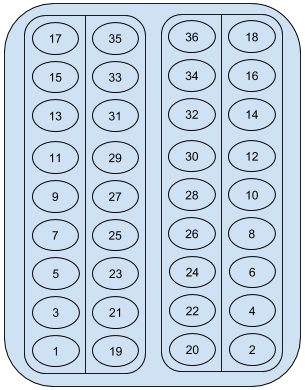codeforces 660B B. Seating On Bus(模拟)
题目链接:
Consider 2n rows of the seats in a bus. n rows of the seats on the left and n rows of the seats on the right. Each row can be filled by two people. So the total capacity of the bus is 4n.
Consider that m (m ≤ 4n) people occupy the seats in the bus. The passengers entering the bus are numbered from 1 to m (in the order of their entering the bus). The pattern of the seat occupation is as below:
1-st row left window seat, 1-st row right window seat, 2-nd row left window seat, 2-nd row right window seat, ... , n-th row left window seat, n-th row right window seat.
After occupying all the window seats (for m > 2n) the non-window seats are occupied:
1-st row left non-window seat, 1-st row right non-window seat, ... , n-th row left non-window seat, n-th row right non-window seat.
All the passengers go to a single final destination. In the final destination, the passengers get off in the given order.
1-st row left non-window seat, 1-st row left window seat, 1-st row right non-window seat, 1-st row right window seat, ... , n-th row left non-window seat, n-th row left window seat, n-th row right non-window seat, n-th row right window seat.
 The seating for n = 9 and m = 36.
The seating for n = 9 and m = 36.You are given the values n and m. Output m numbers from 1 to m, the order in which the passengers will get off the bus.
The only line contains two integers, n and m (1 ≤ n ≤ 100, 1 ≤ m ≤ 4n) — the number of pairs of rows and the number of passengers.
Print m distinct integers from 1 to m — the order in which the passengers will get off the bus.
2 7
5 1 6 2 7 3 4
9 36
19 1 20 2 21 3 22 4 23 5 24 6 25 7 26 8 27 9 28 10 29 11 30 12 31 13 32 14 33 15 34 16 35 17 36 18
题意:
给一个车的状态,问乘客最后下车的次序;
思路:
用队列模拟一下啦;
AC代码:
/* 2014300227 660B - 6 GNU C++11 Accepted 31 ms 2176 KB */ #include <bits/stdc++.h> using namespace std; const int N=1e5+4; typedef long long ll; const double PI=acos(-1.0); queue<int>qu1,qu2,qu3,qu4; int n,m,num1,num2,num3,num4; int main() { scanf("%d%d",&n,&m); for(int i=1;i<=m&&i<=2*n; ) { if(i<=m&&num1<=n){ qu1.push(i); num1++; i++; } if(i<=m&&num2<=n) { qu2.push(i); num2++; i++; } } for(int i=2*n+1;i<=m;) { if(i<=m){ qu3.push(i); i++;} if(i<=m){qu4.push(i); i++;} } while(m) { if(!qu3.empty()) { printf("%d ",qu3.front()); qu3.pop(); m--; } if(!qu1.empty()) { printf("%d ",qu1.front()); qu1.pop(); m--; } if(!qu4.empty()) { printf("%d ",qu4.front()); qu4.pop(); m--; } if(!qu2.empty()) { printf("%d ",qu2.front()); qu2.pop(); m--; } } return 0; }


